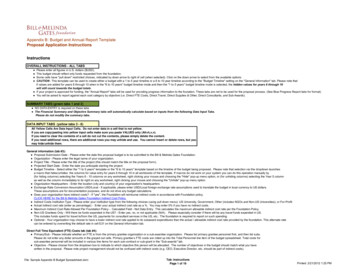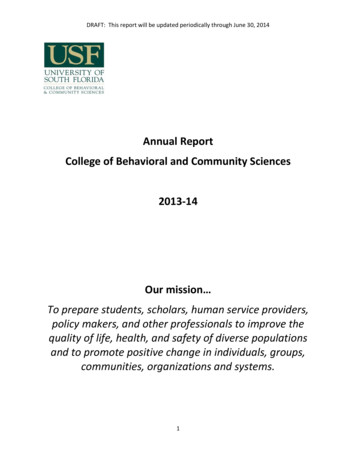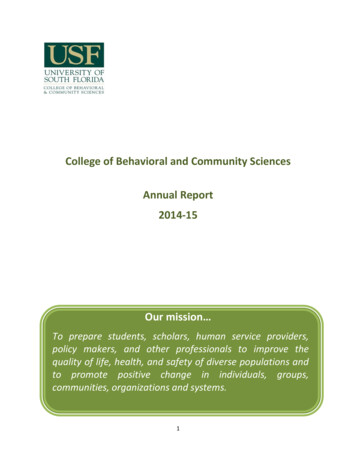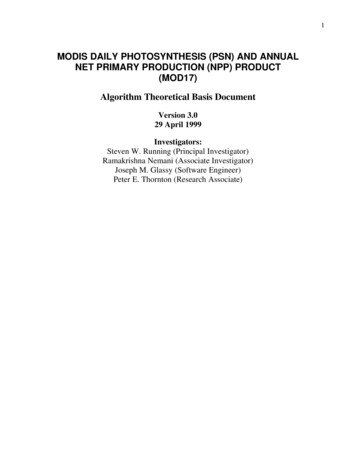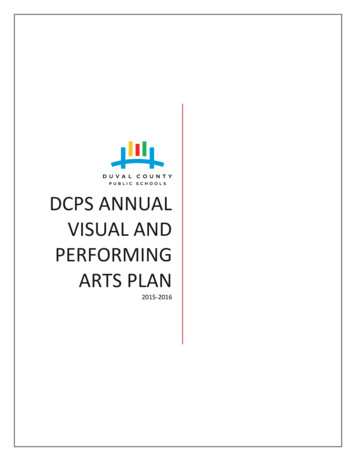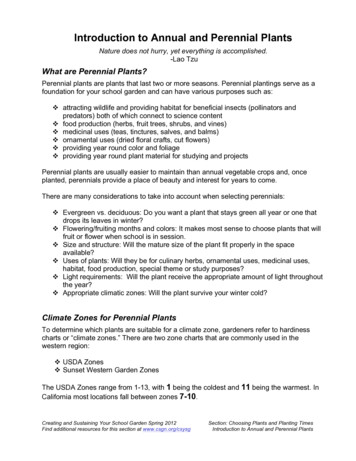
Transcription
Introduction to Annual and Perennial PlantsNature does not hurry, yet everything is accomplished.-Lao TzuWhat are Perennial Plants?Perennial plants are plants that last two or more seasons. Perennial plantings serve as afoundation for your school garden and can have various purposes such as:v attracting wildlife and providing habitat for beneficial insects (pollinators andpredators) both of which connect to science contentv food production (herbs, fruit trees, shrubs, and vines)v medicinal uses (teas, tinctures, salves, and balms)v ornamental uses (dried floral crafts, cut flowers)v providing year round color and foliagev providing year round plant material for studying and projectsPerennial plants are usually easier to maintain than annual vegetable crops and, onceplanted, perennials provide a place of beauty and interest for years to come.There are many considerations to take into account when selecting perennials:v Evergreen vs. deciduous: Do you want a plant that stays green all year or one thatdrops its leaves in winter?v Flowering/fruiting months and colors: It makes most sense to choose plants that willfruit or flower when school is in session.v Size and structure: Will the mature size of the plant fit properly in the spaceavailable?v Uses of plants: Will they be for culinary herbs, ornamental uses, medicinal uses,habitat, food production, special theme or study purposes?v Light requirements: Will the plant receive the appropriate amount of light throughoutthe year?v Appropriate climatic zones: Will the plant survive your winter cold?Climate Zones for Perennial PlantsTo determine which plants are suitable for a climate zone, gardeners refer to hardinesscharts or “climate zones.” There are two zone charts that are commonly used in thewestern region:v USDA Zonesv Sunset Western Garden ZonesThe USDA Zones range from 1-13, with 1 being the coldest and 11 being the warmest. InCalifornia most locations fall between zones 7-10.Creating and Sustaining Your School Garden Spring 2012Find additional resources for this section at www.csgn.org/csysgSection: Choosing Plants and Planting TimesIntroduction to Annual and Perennial Plants
The Sunset Garden Zones are similar to the USDA Zones, but are more detailed allowingfor a more specific match of a plant's ideal environmental preferences and a location'sclimate. There are 24 Sunset zones and the Sunset Western Garden Book is anindispensable resource that lists thousands of plants, their zones and growing informationfor the Western US.To determine your specific zone, ask a local nursery professional, contact your CountyMaster Gardener (www.mastergardeners.org), or view the "Know Your Zone" maps on thefollowing page. To find out what zone a particular plant will thrive in, refer to the plant label,your nursery professional, or a resource such as the Sunset Western Garden Book.Here are a few more points to consider when planting perennials:v “Herbaceous” perennial plants die back to the ground in the winter and re-grow inthe spring. “Woody” plants maintain their branching structure during the winter andmay be evergreen or deciduous. “Evergreen” perennials keep their leaves duringthe winter. Keep these characteristics in mind when planning your garden's design.v Evergreen perennials can be planted any time of the year, but often the best time ofyear is in the fall. This allows plants root systems to get established before theirgrowing season and to take advantage of winter rains.v Bare root perennials such as fruit trees and vines should be planted in the dormantseason (winter or late winter months if your ground is frozen).v Most bulbs are planted in the fall for spring blooming dates; they are a great optionfor school gardens.Creating and Sustaining Your School Garden Spring 2012Find additional resources for this section at www.csgn.org/csysgSection: Choosing Plants and Planting TimesIntroduction to Annual and Perennial Plants
Creating and Sustaining Your School Garden Spring 2012Find additional resources for this section at www.csgn.org/csysgSection: Choosing Plants and Planting TimesIntroduction to Annual and Perennial Plants
What are Annual Plants?Annuals plants are plants the live their whole life cycle (from a planted seed to a matureplant that flowers and fruits and makes a seed again) in a year or less. Annual plants makeup most of our vegetable crops, and most of them can be harvested within 2 to 3 monthsafter sowing. Bi-annual plants are similar to annuals but they may live up to two yearsbefore coming to the end of their lives.Annuals are generally classified as either “warm season” or “cool season” crops.v Cool season crops thrive in cool areas or during cooler months of the year.o Generally they are the root, stem, leaf, and flower bud crops.o Many of these crops can “over winter” in mild winter areas if planted in the fall, orcan be planted in early spring for a late spring harvest.v Warm season crops thrive in warm areas or during the hotter months of the year.o Generally they are the fruit and seed crops.o They are often planted in mid-late spring to summer and harvested in thesummer and fall.School Year Planting OptionsCool Season Crops Late Summer/Fall PlantingHarvest late-fall through winter. Early Spring PlantingHarvest before school ends.Warm Season Crops Late Spring (or Summer*) PlantingHarvest when returning to school infall. (Have a plan in place for summerweeding, watering, and harvest.)Best to sowdirectly intoGarden BedsBest to planttransplants intoGarden BedsBest to sowdirectly intoGarden BedsBest to planttransplants intoGarden BedsBeetsCalendula (edible flower)CarrotsGarlicNasturtium (edible flower)OnionsPeasRadishSpinachAsian ohlrabiLettuceNasturtium (edible tatoesPumpkinsShelling BeansSnap Beans*Summer Squash*Sunflowers (withEggplantOnionsPeppersTomatoesedible seeds)Winter SquashCreating and Sustaining Your School Garden Spring 2012Find additional resources for this section at www.csgn.org/csysgSection: Choosing Plants and Planting TimesIntroduction to Annual and Perennial Plants
Average Last (Spring) and First (Fall)Frost Dates in California CitiesFrom hicoDeath reLodiLompocLong BeachLos AngelesMarysvilleMineralModestoMontereyMt. ShastaNapaNeedlesNevada CityLast 16/134/283/26/4First andOxnardPalmdalePalm SpringsPalo AltoPasadenaPaso RoblesPetalumaPismo BeachPlacervillePomonaRed BluffReddingSacramentoSan DiegoSan FranciscoSan Luis ObispoSanta BarbaraSanta RosaTahoe CityTulelakeUkiahUplandVisaliaWillowsYrekaLast 4/235/31First 8/228/1410/2511/2111/811/89/25Plant Hardiness DefinitionsFrom lHardy Not injured by light frosts and seed will germinate at rather low temperature. May be planted about twoweeks to a month before the average date of the last killing frost in the spring. In general, these plants can safelybe planted as soon as the soil can be worked into condition. Includes: onion sets, smooth peas, cabbageplants (well-hardened), kale, kohlrabi, Brussels sprouts, spinach, turnip, radish, asparagus, rhubarb.Half-Hardy May be planted about the time of the last killing frost. The seeds of this group will germinate at ratherlow temperatures, but the young plants are injured by frost. Includes: lettuce, beet, carrot, chard, parsley,parsnip, heading broccoli, early potatoes, onion seeds, garden peas, celery plants, cauliflower plants.Tender Injured by light frost and does not thrive at low temperatures even though frost does not occur. Theseshouldn’t be planted until all danger of frost is past. Includes: snap bean, tomato, sweet corn, sweet potato.Very Tender Does not thrive until the soil has become warm and the seed will rot in the ground unless the soil iswarm. Includes: eggplant, pepper, cucumber, watermelon, muskmelon, lima bean, squash, pumpkin.Creating and Sustaining Your School Garden Spring 2012Find additional resources for this section at www.csgn.org/csysgSection: Choosing Plants and Planting TimesIntroduction to Annual and Perennial Plants
Planting Annual PlantsGardeners use planting charts (for an example, see Gardens for Learning pages 65-68)or the information found on seed packets to determine when to plant annual plants.Most planting charts and seed packets refer to weeks before or after average frostdates as a guide for when to sow seeds or plant (set) transplants outdoors.The “average last frost date" of the season lands in the late winter or spring. The“average first frost date" lands in the fall or early winter. Planting charts and seedpackets will usually instruct you to plant seeds directly into the garden or transplantseedlings a certain number of weeks before a first frost and before or after a last frost.Contact your local Master Gardeners (found at www.mastergardeners.org) or a localnursery professional, or use Creating and Sustaining Your School Garden's "AverageLast and First Frost Dates in California Cities" to find out your region’s frost dates.Planning Your School's Edible HarvestOne of the most challenging aspects of planning a school garden harvest is that mostcrops are ready for harvest in the summer months, when schools are out of session.With a bit of planning, however, you can create a crop harvest schedule that fits withyour school year.Crop planting charts and seed packets list the “Days to Harvest” of the crop that you areplanting. The days to harvest are an approximation of how many days it will take foryour plant to go from a newly sown seed to an edible treat. Planning your sowing andharvest dates is as simple as selecting seasonally appropriate crops and noting thedays to harvest of the particular crop. Of course there are many other variables like theweather, irrigation, fertilization, and pests that may accelerate or retard a plant's growth,but all of those variables are learning opportunities for gardeners. View the Creating andSustaining Your School Garden Crop Harvest Planning Chart for specifics on planning aschool year harvest.Once you have chosen which crops to plant, read the Creating and Sustaining YourSchool Garden Vegetable Planting and Harvesting Tips, or refer to an online plantingguide at http://csgn.org/crop-planning to learn more about growing and harvesting yourcrops.Planning a Fall HarvestOne mistake many new school gardeners make is planting a garden that maturesduring summer while students are away. In order to plant vegetables that are ready toharvest in the fall, plant longer “days to harvest” vegetable varieties and plant them inthe late spring or early summer. Read the "days to harvest" listing on the back of seedpackages and plan accordingly.Creating and Sustaining Your School Garden Spring 2012Find additional resources for this section at www.csgn.org/csysgSection: Choosing Plants and Planting TimesIntroduction to Annual and Perennial Plants
Another suggestion is to plant crops that can dry in the garden like popcorn, wintersquash (pumpkins), or shelling (dry) beans. Popcorn can dry in the field for weeks oncemature, whereas sweet corn needs to be harvested within a week or two for a tastyharvest. Also remember that many fruiting vegetables need to be harvested to keepproducing throughout the summer, so make sure your summer garden guardiansharvest regularly to encourage continual fruiting.Try planting some of these crops in late May or June and come back to school withsomething to harvest.Shelling Beans (dry beans)Sunflowers (Edible or Birdseed)Winter tMelonsTomatoesParsnipHealth Master CarrotsEdible Theme GardensMany successful school garden programs have learned that planting an edible themegarden is a good way to pique students’ interest, grow healthy food and connect to theclassroom via cultural studies. For example, the Native American Three SistersGarden demonstrates the interdependence of corn (which uses nitrogen added to thesoil by the beans), beans (which grow up the corn stalks), and squash (which covers theground and reduces weed growth). Another popular example is a pizza garden, inwhich everything needed to make a pizza can be grown (add a statue of a cow torepresent the source of cheese and a pig the “pizza meat” animal).Creating and Sustaining Your School Garden Spring 2012Find additional resources for this section at www.csgn.org/csysgSection: Choosing Plants and Planting TimesIntroduction to Annual and Perennial Plants
Crop Harvest Planning ChartPlant carrots in January and you'll never have to eat carrots. Author unknownAverage Frost DatesMost seed packets and planting guides recommend the number of weeks to plant ortransplant (set out plants) before or after the average first or last frost date in your area.Refer to the average frost date chart and write your average frost dates below:Last Frost (Spring):First Frost (Fall):Planning Planting andHarvest Dates1. Review the school year plantingoptions list for a summary of schoolyear planting/harvest windows.2. With your average frost dates notedrefer to a seed packet or plantingguide for more specific details onwhen to plant.3. Use a seed packet or planting guideto find the number of days untilharvest. “Days to Harvest” are basedon the day that the seed is first putinto soil (container or direct sown).4. Chose a crop and fill out the chartbelow selecting a harvest date whenschool is in session.CropExample: LettucePlanting DatethApril 10Number of Daysto Harvest50 days from direct seedTarget Datefor HarvestthMay 30Keep in mind the weather and a number of other factors can affect the number of daysto harvest. If you are planting a transplant, you can subtract about 20-30 days off the“days to harvest” found on seed packets and planting guides. Note: some seed packets(such as tomatoes and peppers) state the days to harvest from setting out a transplant.Creating and Sustaining Your School Garden Spring 2012Find additional resources for this section at www.csgn.org/csysgSection: Choosing Plants and Planting TimesIntroduction to Annual and Perennial Plants
planted, perennials provide a place of beauty and interest for years to come. . Chico 4/23 10/30 Petaluma 4/25 11/5 . when schools are out of session. With a bit of planning, howev



